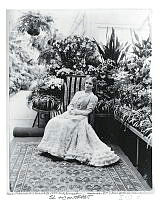Miss Lane's Conservatory, at the W.H., Washington
This lithograph published in Frank Leslie's Illustrated Newspaper in 1858 depicts the newly added White House Conservatory. In the print, presumably, is Harriet Lane, President James Buchanan's niece who served as White House hostess during his administration, standing in the Conservatory. The Conservatory was built during Buchanan's administration and stood on the grounds of what is today the West Colonnade and West Wing. The Conservatory had a small, 12 foot passage between the glass room and the Executive Mansion and served as a private space for first families of the era. P. Hall Baglie is credited with the tinting of this lithograph.








